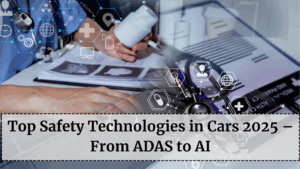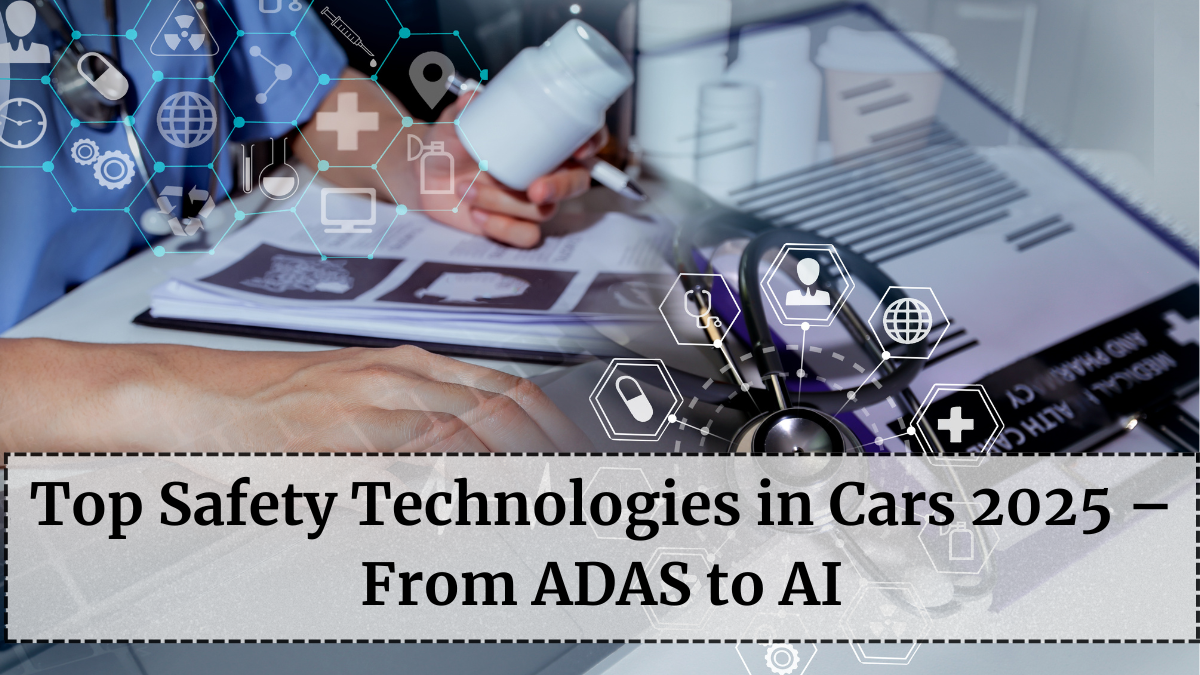Car safety has evolved far beyond seatbelts and airbags. In 2025, artificial intelligence, sensors, and automation are redefining how vehicles prevent accidents before they even happen. The modern car is not just a mode of transport — it’s a smart guardian designed to protect you from every angle.
India, too, is catching up fast. With new safety mandates, global collaborations, and tech integration in both affordable and luxury cars, car safety tech in 2025 is setting unprecedented standards for driver and passenger protection.
Let’s explore the most advanced automotive safety technologies that are shaping the roads of 2025.

Understanding Modern Car Safety
The Shift from Passive to Active Safety
Earlier, safety systems were passive, designed to protect passengers after a crash (like airbags or crumple zones). Today, the focus has shifted to active safety — technologies that predict, prevent, and respond to potential hazards in real time using AI and sensors.
Key Components of Safety Tech
-
AI & Machine Learning: Predict driving behavior and adapt to road conditions.
-
Radar, Cameras, and LiDAR: Enable object detection and 360° vision.
-
Cloud Connectivity: Provides over-the-air updates and real-time hazard alerts.
Top Car Safety Technologies in 2025
1. Advanced Driver Assistance Systems (ADAS)
ADAS is the foundation of modern car safety. It uses cameras, radar, and AI to support the driver in avoiding collisions and staying in control.
Core ADAS features include:
-
Adaptive Cruise Control: Automatically maintains distance from vehicles ahead.
-
Lane Keep Assist: Warns and corrects unintentional lane drifts.
-
Blind Spot Monitoring: Alerts when vehicles approach from unseen angles.
-
Forward Collision Warning: Detects sudden braking ahead and preps the brakes.
-
Autonomous Emergency Braking (AEB): Applies brakes automatically if a collision is imminent.
In India, manufacturers like Hyundai, Mahindra, and Honda are offering ADAS even in mid-range models like the XUV700 and Verna 2025.
2. AI-Based Driver Monitoring Systems (DMS)
Fatigue and distraction are among the leading causes of road accidents. The Driver Monitoring System uses infrared cameras and AI to track eye movement, head position, and attention span.
If it detects drowsiness or distraction, it alerts the driver or even slows the vehicle automatically. This system is now mandatory in the EU and being adopted by premium Indian models as well.
3. Autonomous Emergency Braking (AEB)
In 2025, AEB has become a global standard. Using forward-facing radar and cameras, it detects obstacles, pedestrians, or other vehicles and applies brakes automatically.
Some systems can even differentiate between humans, animals, and static objects, preventing accidents in complex traffic conditions.
4. 360° Surround View and Parking Assist
Parking accidents are still common in urban areas. The 360° camera system combines feeds from multiple cameras to create a bird’s-eye view, helping drivers park with precision.
AI-based parking assist systems can now automatically maneuver vehicles into tight spaces, taking full control of steering, throttle, and brakes.
5. Collision Avoidance and Cross-Traffic Alerts
Modern cars use rear radars and side sensors to warn of vehicles approaching from either direction while reversing or changing lanes. In 2025, this system is integrated with automatic braking, preventing side and rear-end collisions.
6. AI Crash Prediction Algorithms
New-generation safety systems use AI crash prediction models trained on millions of accident scenarios. These systems can calculate the probability of a crash based on driver speed, distance, and steering inputs — and take preventive actions instantly.
7. Pedestrian and Cyclist Detection
Pedestrian safety is now a global priority. Advanced sensors identify pedestrians or cyclists even at night and automatically slow the vehicle, especially in school zones or dense traffic.
8. Vehicle-to-Vehicle (V2V) and Vehicle-to-Infrastructure (V2I) Communication
In 2025, connected cars communicate directly with each other and nearby infrastructure using 5G-based V2X (Vehicle-to-Everything) technology.
This system shares data about road hazards, weather, or traffic lights, giving drivers and vehicles extra seconds to react — preventing accidents before they occur.
9. Smart Airbags and Adaptive Restraint Systems
Airbags in 2025 are smarter and more responsive. Adaptive airbags adjust deployment speed and intensity based on passenger size, seat position, and crash severity.
In some luxury EVs, external airbags protect pedestrians during impact — a leap toward inclusive safety innovation.
10. Predictive Maintenance and Health Alerts
Through real-time diagnostics, cars can now detect mechanical faults or worn-out brakes and notify drivers before a safety risk develops. AI systems even monitor tire pressure, steering vibration, and fluid levels to predict failures early.
Safety Regulations and Ratings in 2025
Bharat NCAP and Global NCAP Standards
India’s Bharat NCAP safety rating system, aligned with global norms, now requires six airbags, electronic stability control (ESC), and pedestrian safety standards in all passenger cars.
Mandatory ADAS by 2026
The Indian government plans to make Level 1 and Level 2 ADAS mandatory for all vehicles above ₹15 lakh by 2026, ensuring that even budget cars get essential safety tech.
Insurance Benefits for Safer Cars
Insurance companies are offering discounted premiums for vehicles equipped with ADAS and advanced safety systems, encouraging safer driving choices.
How AI Is Transforming Safety in Cars
Artificial Intelligence plays a key role in making safety proactive. AI enables vehicles to learn driver behavior, anticipate risks, and make split-second adjustments.
For instance, Tesla’s Autopilot, Volvo’s Pilot Assist, and Mercedes’ Drive Pilot are continuously learning systems that improve safety over time through software updates.
AI also powers real-time data sharing with nearby vehicles, enabling collective road awareness — a foundation for future fully autonomous cars.
The Road Ahead – Safer, Smarter, Self-Aware Cars
By 2030, experts expect every new vehicle to come equipped with AI-based safety systems by default. The evolution from driver assistance to driver replacement is already in motion, with human error gradually being replaced by machine precision.
In India, rising road safety awareness, government regulations, and consumer demand are driving this transition. As technology becomes affordable, these innovations will no longer be limited to premium cars — they’ll protect everyone on the road.
FAQs
What is the most important car safety technology in 2025?
ADAS remains the most impactful safety system, combining lane assistance, automatic braking, and adaptive cruise control to prevent accidents.
Are ADAS and autonomous driving the same?
No. ADAS supports the driver with safety alerts and automatic actions, while autonomous driving allows the car to operate without human input.
Do Indian cars have ADAS features now?
Yes, vehicles like the Mahindra XUV700, Hyundai Verna, and Honda Elevate offer ADAS systems even in mid-range variants.
How does AI improve car safety?
AI processes data from cameras and sensors to predict risks, assist drivers, and enhance real-time response during emergencies.
Are ADAS features expensive to maintain?
Not significantly. Most ADAS systems use software updates and basic sensor calibration during servicing, keeping maintenance affordable.
Click here to know more.
